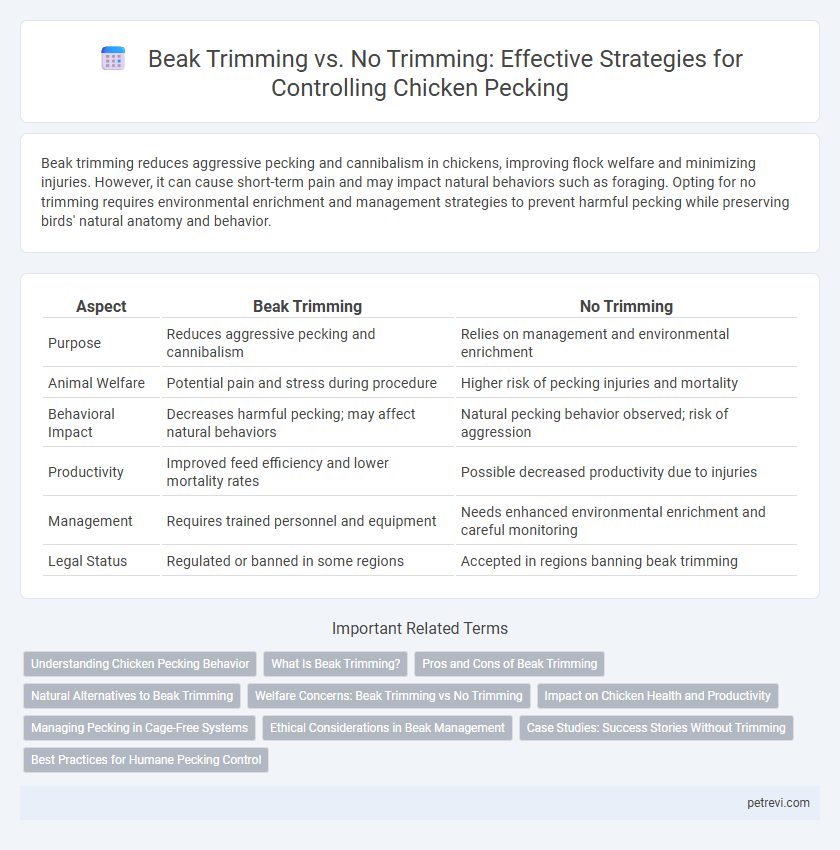Beak trimming reduces aggressive pecking and cannibalism in chickens, improving flock welfare and minimizing injuries. However, it can cause short-term pain and may impact natural behaviors such as foraging. Opting for no trimming requires environmental enrichment and management strategies to prevent harmful pecking while preserving birds' natural anatomy and behavior.
Table of Comparison
| Aspect | Beak Trimming | No Trimming |
|---|---|---|
| Purpose | Reduces aggressive pecking and cannibalism | Relies on management and environmental enrichment |
| Animal Welfare | Potential pain and stress during procedure | Higher risk of pecking injuries and mortality |
| Behavioral Impact | Decreases harmful pecking; may affect natural behaviors | Natural pecking behavior observed; risk of aggression |
| Productivity | Improved feed efficiency and lower mortality rates | Possible decreased productivity due to injuries |
| Management | Requires trained personnel and equipment | Needs enhanced environmental enrichment and careful monitoring |
| Legal Status | Regulated or banned in some regions | Accepted in regions banning beak trimming |
Understanding Chicken Pecking Behavior
Chicken pecking behavior is a natural social interaction used to establish pecking order, communicate, and explore their environment, which can occasionally lead to harmful feather pecking or cannibalism. Beak trimming reduces the damage caused by pecking but can cause pain and affect natural behaviors, whereas no trimming relies on environmental enrichment and flock management to minimize aggressive pecking. Understanding triggers like overcrowding, stress, and lack of stimulation helps in applying non-invasive pecking control methods that maintain bird welfare and productivity.
What Is Beak Trimming?
Beak trimming is a management practice used in poultry farming to reduce aggressive pecking and cannibalism among chickens by carefully removing a portion of the beak's tip. This procedure aims to minimize injuries and stress caused by excessive pecking, which can negatively impact flock health and productivity. Techniques for beak trimming typically involve hot blade or infrared methods, performed during the early stages of a chick's life to promote healing and adaptation.
Pros and Cons of Beak Trimming
Beak trimming in chickens reduces aggressive pecking and cannibalism, improving flock welfare and minimizing injuries. However, this procedure can cause acute pain and stress, potentially impacting feeding behavior and growth rates. Choosing beak trimming requires balancing animal welfare concerns with effective pecking control to optimize overall production outcomes.
Natural Alternatives to Beak Trimming
Natural alternatives to beak trimming for controlling chicken pecking include environmental enrichment, such as providing perches, dust baths, and varied foraging materials to reduce boredom and aggression. Selective breeding for docile strains can also decrease pecking behaviors without physical alteration. Managing flock density and ensuring balanced nutrition further minimize stress-induced pecking, promoting welfare-friendly practices.
Welfare Concerns: Beak Trimming vs No Trimming
Beak trimming in chickens reduces aggressive pecking and feather damage, promoting flock welfare by minimizing injuries, but it raises concerns about pain and sensory loss during and after the procedure. No trimming preserves natural beak function and reduces acute pain but may increase the risk of severe pecking injuries and cannibalism, impacting overall flock health. Welfare-focused management practices balance these factors by enhancing environmental enrichment and flock monitoring to mitigate pecking behavior without excessive reliance on beak trimming.
Impact on Chicken Health and Productivity
Beak trimming reduces the risk of severe injuries caused by aggressive pecking, improving overall flock health and minimizing stress-related behaviors that can decrease egg production. However, improper beak trimming may lead to pain and feeding difficulties, potentially lowering growth rates and productivity. Maintaining optimal environmental enrichment and nutrition can mitigate pecking without trimming, supporting natural behaviors and sustaining high productivity in well-managed flocks.
Managing Pecking in Cage-Free Systems
Beak trimming reduces feather pecking and cannibalism in cage-free chicken systems by minimizing injury risks and stress-induced behaviors. No trimming requires enhanced environmental enrichment, such as perches and foraging materials, to redirect pecking and maintain flock welfare. Effective management of pecking in cage-free systems balances behavioral needs with injury prevention through strategic husbandry practices.
Ethical Considerations in Beak Management
Beak trimming in chickens is a common practice aimed at reducing pecking injuries and cannibalism in flocks, but it raises significant ethical concerns regarding animal welfare. The procedure, often performed without anesthesia, can cause acute and chronic pain, impacting the bird's ability to perform natural behaviors such as foraging and preening. Ethical beak management requires exploring alternatives like environmental enrichment, selective breeding for less aggressive traits, and improved housing conditions to minimize the need for beak trimming while promoting the overall well-being of chickens.
Case Studies: Success Stories Without Trimming
Case studies demonstrate that implementing environmental enrichments, such as perches and foraging materials, effectively reduces pecking behavior in chickens without the need for beak trimming. Research from sustainable poultry farms highlights success by promoting natural behaviors and maintaining flock hierarchy, which decreases injurious pecking incidents. These findings support welfare-friendly management practices as viable alternatives to physical interventions in commercial and backyard chicken rearing.
Best Practices for Humane Pecking Control
Beak trimming, when performed with precision and proper anesthesia, can reduce injurious pecking and improve flock welfare by minimizing aggressive behaviors. No trimming requires implementing environmental enrichment, adequate space, and balanced nutrition to naturally deter pecking, supporting humane management practices. Combining early socialization and stress reduction techniques further enhances pecking control while prioritizing the chickens' well-being and ethical treatment.
Beak Trimming vs No Trimming for Chicken Pecking Control Infographic

 petrevi.com
petrevi.com